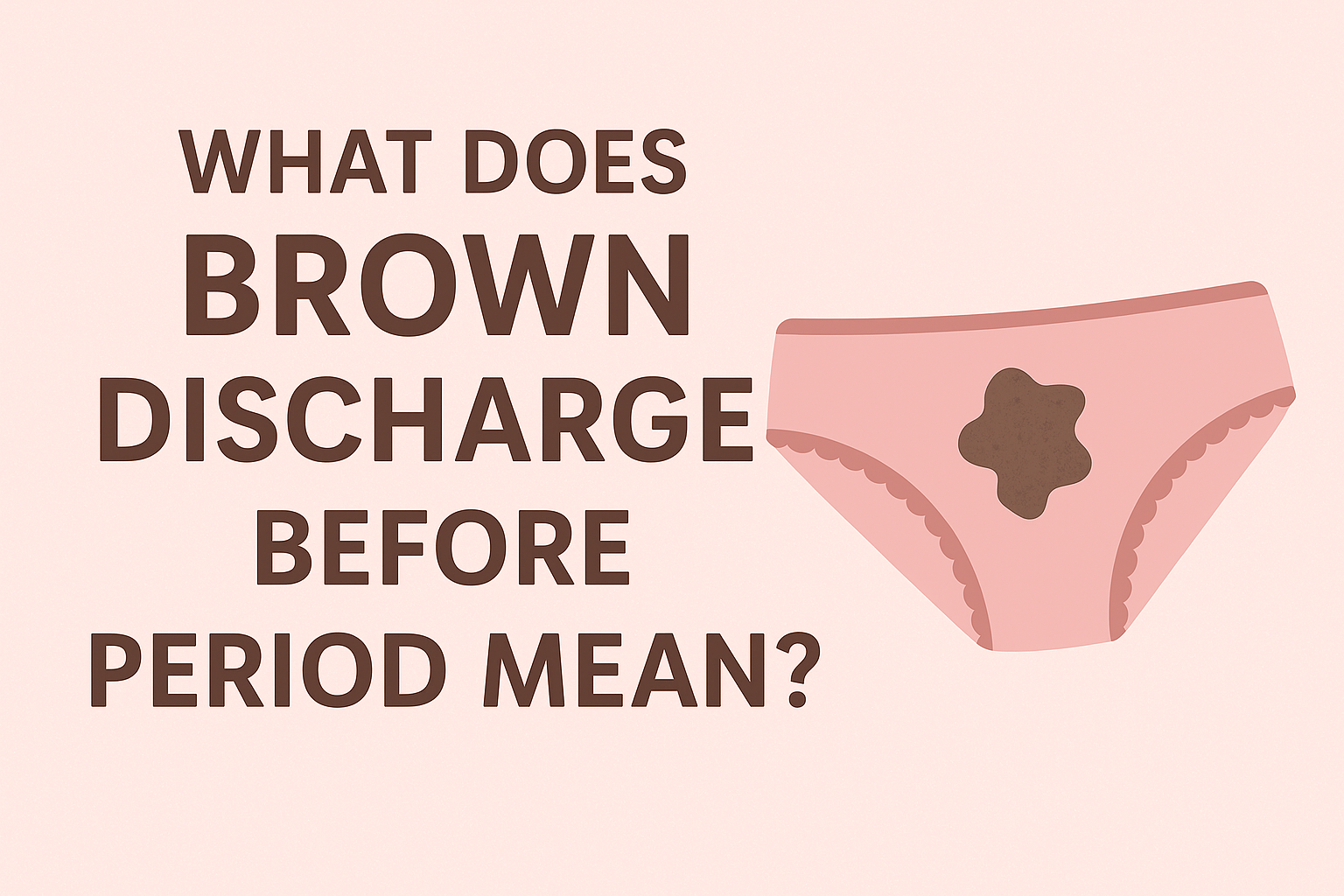
⚠️ Affiliate Disclaimer: This post may contain affiliate links, which means I may earn a small commission — at no extra cost to you — if you make a purchase through one of these links. I only recommend products or services I genuinely trust and believe can provide value. Thank you for supporting My Medical Muse!
Brown Discharge Before Period: 7 Alarming Causes & When to Worry
What Does Brown Discharge Before Period Mean?
Vaginal discharge is a natural and essential part of the female reproductive system. It plays an important role in keeping the vagina clean, maintaining the right pH balance, and protecting against infections by flushing out dead cells and bacteria. Throughout the menstrual cycle, the color, texture, and amount of discharge can change due to shifting hormone levels especially estrogen and progesterone.
Most women are familiar with clear, white, or slightly milky discharge, which is considered normal. However, sometimes the discharge may appear brown just before the menstrual period begins. This can be surprising or even alarming, particularly if you’re not sure what it means.
The truth is, in many cases, brown discharge before a period is completely harmless. It often indicates the presence of old blood leaving the uterus, which may have taken longer to exit the body and turned brown as it oxidized. Still, because brown discharge can also be linked to hormonal changes, pregnancy, infections, or underlying health conditions, it’s natural to wonder whether it’s something you should be concerned about.
So, what does brown discharge before your period really mean? Is it simply part of your body’s natural rhythm, or could it be signaling a deeper issue that requires medical attention?
In this comprehensive guide, we’ll break down everything you need to know about brown discharge before your period, including:
- Common causes (from old blood to hormonal shifts and beyond)
- When it’s normal vs. when it may signal a problem
- Possible links to pregnancy and reproductive health conditions
- Tips for managing and preventing unusual discharge
- Signs that tell you it’s time to see a doctor
By the end of this article, you’ll have a clearer understanding of why brown discharge happens, what your body may be trying to tell you, and how to take the right steps to care for your reproductive health.
Understanding Vaginal Discharge
Why Does Vaginal Discharge Happen?
Vaginal discharge is a completely normal and healthy function of the female body. It acts as the vagina’s natural self-cleaning system, helping to:
- Keep the vagina lubricated and comfortable
- Flush out dead cells and bacteria, preventing infections
- Maintain the right pH balance for reproductive health
The amount, color, and consistency of discharge are influenced by hormonal changes throughout the menstrual cycle, especially estrogen and progesterone. This is why your discharge may look different at the start, middle, and end of your cycle.
Normal Discharge vs. Abnormal Discharge
It’s important to know what’s considered normal versus what might be a cause for concern:
Normal discharge
- Clear, watery, or milky white
- Mild or no odor
- May become stretchy and slippery during ovulation
- Changes naturally with different phases of the menstrual cycle
- Clear, watery, or milky white
Abnormal discharge
- Thick, chunky, or cottage cheese-like
- Yellow, green, or gray in color
- Strong, foul, or fishy odor
- Accompanied by itching, burning, pain, or pelvic discomfort
- Thick, chunky, or cottage cheese-like
Brown discharge can be either normal or abnormal, depending on its timing, frequency, and whether other symptoms are present.
What Does Brown Discharge Indicate?
The Role of Old Blood
One of the most common reasons for brown discharge is old blood leaving the uterus. When blood lingers in the body longer than usual, it undergoes oxidation turning from bright red to dark brown. This process is completely natural and often harmless.
Timing Matters
The timing of brown discharge offers important clues about its cause:
Before your period
- Often normal, signaling the uterus is starting to shed its lining.
- Typically light and short-lived.
- Often normal, signaling the uterus is starting to shed its lining.
After your period
- Also common, as the body clears out any leftover menstrual blood.
- Usually lasts a day or two.
- Also common, as the body clears out any leftover menstrual blood.
Mid-cycle (around ovulation)
- Can occur as light spotting due to hormonal fluctuations or ovulation itself.
- Should be monitored, if frequent or accompanied by pain, it may require further evaluation.
- Can occur as light spotting due to hormonal fluctuations or ovulation itself.
In most cases, brown discharge is just your body’s way of completing the menstrual cycle. However, if it happens regularly, lasts for several days, or is paired with unpleasant symptoms, it may point to a deeper issue that needs medical attention.
Common Causes of Brown Discharge Before Period
Brown discharge before menstruation is relatively common, and in most cases, it’s linked to natural changes in the body. However, it can also be a sign of an underlying issue depending on the circumstances. Below are the most common causes to consider:
1. Old Menstrual Blood
The most frequent and harmless reason for brown discharge is simply leftover menstrual blood from the previous cycle. Sometimes, small amounts of blood remain in the uterus and take longer to exit the body. As this older blood oxidizes, it changes from bright red to a brown or even dark brown shade.
This usually shows up as light spotting right before your next period begins and should not be a cause for concern.
2. Hormonal Imbalances
Your menstrual cycle depends on the delicate balance between estrogen and progesterone. When these hormones fluctuate, the timing of ovulation and menstruation can be disrupted, leading to spotting or brown discharge.
Common triggers for hormonal imbalance include:
- High levels of stress
- Sudden weight changes (loss or gain)
- Excessive exercise or overtraining
- Thyroid disorders (underactive or overactive thyroid)
When hormonal shifts are the cause, you may also notice irregular cycles, mood changes, or changes in flow intensity.
3. Ovulation Spotting
Some women experience light spotting around ovulation, which occurs roughly 10-14 days before the start of their period. This spotting may be pink, red, or brown, depending on how quickly the blood exits the body.
Ovulation spotting is usually mild, short-lived, and not associated with pain. However, if it happens frequently or is accompanied by discomfort, it’s worth discussing with a healthcare provider.
4. Implantation Bleeding
For women who are sexually active and possibly trying to conceive, brown discharge before a period can be an early sign of pregnancy known as implantation bleeding. This occurs when a fertilized egg attaches itself to the uterine lining.
Typical features of implantation bleeding:
- Appears 6-12 days after ovulation
- Much lighter than a normal period
- Usually lasts 1-3 days
- May be pink or brown in color rather than bright red
Not all women experience implantation bleeding, but when it occurs, it is often mistaken for an unusually light or early period.
5. Birth Control Use
Hormonal contraceptives such as pills, patches, hormonal IUDs, or injections often affect bleeding patterns, particularly in the first few months of use. They can cause breakthrough bleeding or brown spotting as the body adjusts to the artificial hormones.
Missing pills or inconsistent use may also trigger brown discharge. If spotting persists beyond the adjustment period (3-6 months), consult your doctor about changing your contraceptive method or dosage.
6. Perimenopause
During perimenopause (the transitional stage before menopause), estrogen and progesterone levels fluctuate unpredictably. This hormonal shift can cause irregular cycles, lighter or heavier bleeding, and episodes of brown discharge before periods.
Women in their late 30s to 40s often notice these changes, along with symptoms such as hot flashes, sleep disturbances, and mood swings.
7. Infections
Brown discharge may also be a symptom of an underlying vaginal or reproductive tract infection, particularly if it’s accompanied by other signs such as odor, itching, or pelvic pain.
Common culprits include:
- Bacterial vaginosis (BV): often produces a fishy odor along with discharge
- Yeast infections: may cause itching, irritation, and thick discharge
- Sexually transmitted infections (STIs): such as chlamydia, gonorrhea, or trichomoniasis, which may lead to brown discharge, pain during sex, or urinary discomfort
Prompt treatment is important, as untreated infections can affect fertility and overall reproductive health.
8. Uterine or Cervical Conditions
In some cases, brown discharge before a period may point to an underlying gynecological condition. These include:
- Uterine fibroids: noncancerous growths in the uterus that may cause heavy bleeding, spotting, or pelvic pain
- Endometriosis: a condition where tissue similar to the uterine lining grows outside the uterus, leading to spotting, painful periods, or infertility
- Cervical polyps: small growths on the cervix that can cause irregular bleeding or brown discharge
- Cervical or uterine cancer (rare): brown discharge, especially postmenopausal, can sometimes be an early warning sign
While these conditions are less common than hormonal or lifestyle-related causes, they should not be ignored, especially if symptoms are persistent or worsening.
Most causes of brown discharge before your period are harmless, but when it happens often, is accompanied by pain, odor, or unusual bleeding, it may require medical attention.
Symptoms to Watch Alongside Brown Discharge
While brown discharge on its own is often harmless, certain accompanying symptoms may signal that something more serious is going on. It’s important to monitor for the following red flags:
- Strong, foul odor: May indicate a bacterial infection or STI.
- Pain during intercourse (dyspareunia): Can be linked to infections, cervical issues, or endometriosis.
- Pelvic or abdominal pain: Persistent cramping or discomfort may point to fibroids, infections, or pregnancy complications.
- Itching or burning sensation: Often associated with yeast infections, bacterial vaginosis, or STIs.
- Heavy or prolonged spotting between cycles: Could suggest hormonal imbalance, uterine fibroids, or other gynecological conditions.
- Postmenopausal spotting: Always requires medical evaluation, as it may indicate endometrial or cervical changes.
If you notice any of these symptoms along with brown discharge, it’s best to consult a healthcare provider rather than wait for them to resolve on their own.
Brown Discharge and Pregnancy
Brown discharge can also occur in pregnancy, and while it may be harmless in some cases, it can also signal complications. Distinguishing between causes is crucial.
Implantation vs. Miscarriage
Implantation bleeding
- Occurs when a fertilized egg attaches to the uterine lining.
- Usually light brown or pink in color.
- Brief (1-3 days) and very mild.
- Happens about 6-12 days after ovulation.
- Often mistaken for an early or light period.
- Occurs when a fertilized egg attaches to the uterine lining.
Threatened miscarriage
- May begin as brown spotting.
- Often progresses to heavier bleeding.
- Accompanied by cramping, back pain, or tissue passing from the vagina.
- Requires immediate medical attention to assess viability of the pregnancy.
- May begin as brown spotting.
Ectopic Pregnancy
An ectopic pregnancy occurs when the fertilized egg implants outside the uterus, usually in the fallopian tube. This is a life-threatening emergency.
Symptoms may include:
- Brown or dark red discharge
- Sharp, one-sided pelvic pain
- Shoulder pain (caused by internal bleeding irritating the diaphragm)
- Dizziness, fainting, or weakness
If you suspect an ectopic pregnancy, seek emergency medical help immediately.
Diagnosis: How Doctors Evaluate Brown Discharge
If you visit a healthcare provider about brown discharge, they will carry out a thorough evaluation to determine the cause.
Medical History & Symptom Review
Your doctor will likely ask questions such as:
- When did the discharge start, and how long has it lasted?
- Do you notice a pattern in relation to your menstrual cycle?
- Are you sexually active, and what type of contraception do you use?
- Are there other symptoms (pain, odor, itching, fever, irregular cycles)?
- Could pregnancy be a possibility?
Physical and Pelvic Exam
A pelvic exam allows the doctor to check for visible signs of:
- Infections
- Cervical polyps
- Abnormalities in the uterus or cervix
- Signs of irritation or inflammation
Tests That May Be Ordered
To confirm a diagnosis, your doctor may recommend one or more of the following tests:
- Pap smear: Screens for abnormal cervical cells and HPV-related changes.
- Blood tests: Assess hormone levels, check for infections, or confirm pregnancy.
- Ultrasound scan: Provides a view of the uterus and ovaries, useful for detecting fibroids, cysts, or endometrial thickening.
- Pregnancy test (blood or urine): To confirm or rule out pregnancy.
- Vaginal swab or culture: Identifies bacterial, fungal, or STI-related infections.
Together, these evaluations help your healthcare provider pinpoint whether the discharge is part of a normal cycle variation or a sign of something requiring treatment.
Treatment Options
The treatment for brown discharge before your period depends entirely on the underlying cause. In many cases, no treatment is needed, but if it’s linked to a medical issue, a targeted approach will be recommended by your healthcare provider.
1. If It’s Normal (Old Blood)
- No treatment is required if the discharge is simply old menstrual blood.
- Practicing good hygiene and wearing breathable cotton underwear can help you feel more comfortable.
2. Hormonal Imbalances
When irregular hormone levels are to blame, treatment may include:
- Lifestyle changes: Managing stress, maintaining a healthy weight, eating a balanced diet, and exercising regularly can help restore balance.
- Hormonal therapy: In some cases, doctors may prescribe hormonal treatments (such as birth control pills or hormone replacement therapy) to regulate cycles.
3. Birth Control Adjustments
- Spotting and brown discharge are common side effects of hormonal contraceptives.
- If breakthrough bleeding persists, your doctor may suggest adjusting your dosage or switching to another form of birth control better suited to your body.
4. Infections
If an infection is detected, treatment typically includes:
- Antibiotics: for bacterial infections like bacterial vaginosis or certain STIs.
- Antifungal medication: for yeast infections.
- STI treatment: both partners may need to be treated to prevent reinfection.
5. Uterine or Cervical Conditions
In more complex cases, such as fibroids, endometriosis, or polyps, treatment may involve:
- Minimally invasive surgery (laparoscopy, hysteroscopy, or removal of growths).
- Pain management for endometriosis or fibroid-related discomfort.
- Cancer-specific treatment (surgery, chemotherapy, or radiation) in the rare event of a cancer diagnosis.
Self-Care and Prevention
While not all causes of brown discharge can be prevented, adopting healthy habits can reduce the risk of abnormal changes and promote better reproductive health.
- Track your cycle: Use a menstrual app or calendar to monitor patterns in your discharge and periods. This helps you identify what’s normal for your body.
- Practice safe sex: Use condoms or other protective methods to reduce the risk of STIs.
- Maintain good hygiene: Wash the external genital area with mild, unscented soap and warm water. Avoid douching, as it can disrupt the vaginal pH and increase infection risk.
- Live a balanced lifestyle: Eat nutrient-rich foods, get adequate sleep, manage stress, and avoid extreme weight fluctuations.
- Schedule regular checkups: Annual gynecological visits, including Pap smears and pelvic exams, help detect problems early even before symptoms appear.
When to See a Doctor
Brown discharge before your period is usually harmless, but there are times when medical evaluation is essential. Seek professional advice if:
- Brown discharge persists beyond two menstrual cycles.
- It is accompanied by a strong odor, itching, or pelvic pain.
- You experience heavy or prolonged bleeding between periods.
- You suspect pregnancy complications (such as miscarriage or ectopic pregnancy).
- You notice spotting after menopause, which should always be investigated.
Occasional brown discharge is normal, but if it feels unusual for your body or comes with other concerning symptoms, don’t ignore it, schedule a visit with your doctor.
FAQs
1. Is brown discharge always a sign of pregnancy?
- No. While brown discharge can sometimes be linked to implantation bleeding in early pregnancy, it is far more often caused by old menstrual blood that took longer to leave the uterus.
2. Can stress cause brown discharge?
- Yes. High stress levels can disrupt the balance of estrogen and progesterone, leading to irregular spotting, delayed periods, or changes in discharge color, including brown discharge.
3. Should I worry about brown discharge before my period?
- Not necessarily. In most cases, it’s normal and harmless. However, if it becomes persistent, unusually heavy, or is paired with pain, odor, or itching, you should consult a healthcare provider.
4. Does brown discharge mean infertility?
- No. Occasional brown discharge does not mean infertility. Many women who experience spotting still conceive and have healthy pregnancies. Persistent abnormal discharge, however, may be linked to conditions (like endometriosis or fibroids) that can affect fertility, so it’s best to monitor and seek advice if needed.
5. How long does implantation bleeding last?
Implantation bleeding typically lasts 1-3 days. It is lighter than a normal period, usually pink or brown in color, and rarely heavy enough to require pads or tampons.
Conclusion
Brown discharge before your period is usually a normal part of the menstrual cycle, most often caused by old blood, hormonal changes, or ovulation. For many women, it’s a harmless occurrence that requires no treatment.
That said, brown discharge can sometimes point to more serious issues such as infections, pregnancy-related complications, or uterine and cervical conditions. The key is to pay attention to timing, patterns, and accompanying symptoms.
- If it happens occasionally without discomfort, there’s usually no need to worry.
- If it’s persistent, foul-smelling, painful, unusually heavy, or occurs after menopause, it’s best to seek medical advice.
By tracking your cycle, maintaining healthy habits, and attending regular gynecological checkups, you can better understand what’s normal for your body and catch potential problems early.
Your body often communicates through subtle signs, brown discharge is one of them, knowing what it means empowers you to take charge of your reproductive health with confidence.
👩⚕️ Need Personalized Health Advice?
Get expert guidance tailored to your unique health concerns through MuseCare Consult. Our licensed doctors are here to help you understand your symptoms, medications, and lab results—confidentially and affordably.
👉 Book a MuseCare Consult NowRelate Blog Post You Might Like:
- 10 Powerful Reasons Why Your Period Is Late but Pregnancy Test Is Negative
- 10 Essential Facts Every Woman Must Know About Ovarian Cysts
- Managing Stress During IVF: 10 Powerful Tips for Emotional Well-being
- Understanding the Impact of Age on Female Fertility: 9 Powerful Facts
- Migraines in Women: 10 Powerful Reasons They’re 3x More Common Than Men
- 7 Powerful Insights on Osteoporosis in Women Under 50


